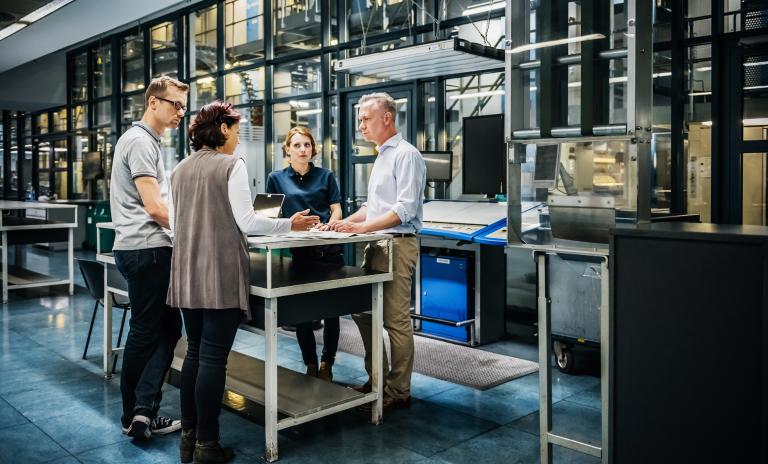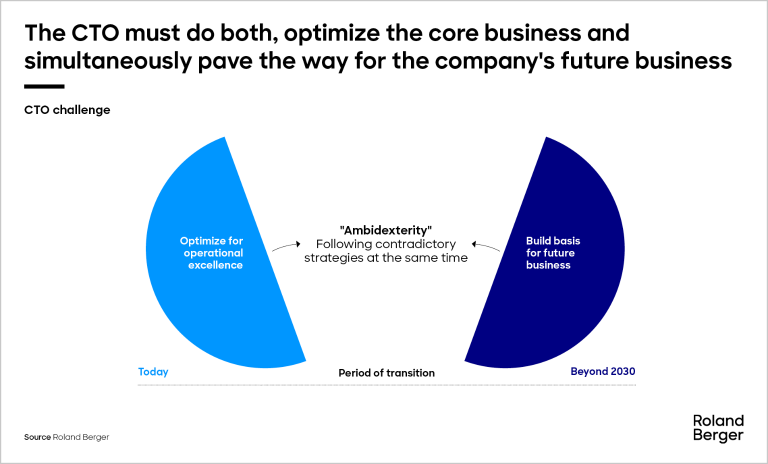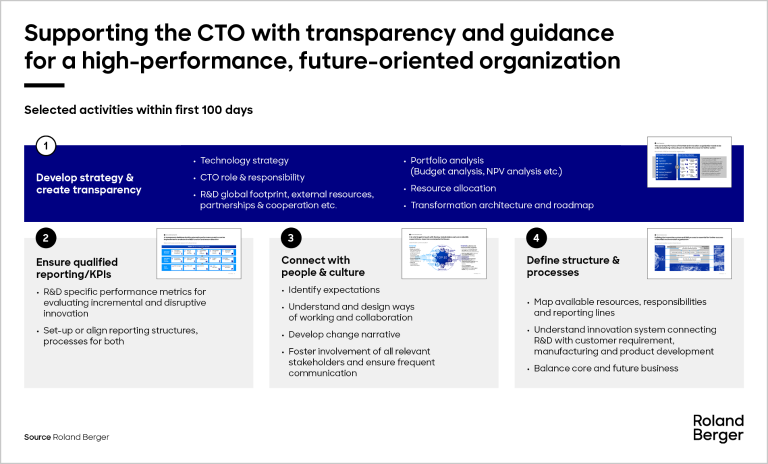The Roland Berger model for robust and future-proof operations makes companies adaptable, agile and resilient.


CTO 2030: Redefining the role of the CTO
By Julia Duwe and Steffen Gackstatter
Preparing for the future and securing today’s core business is the challenge
As we look towards 2030, the world will be strongly influenced by the effects of today’s global turbulences, trends and transformations: From ongoing climate change, supply chain disruptions, geopolitical tensions and power shifts to labor scarcety and a technology transformation towards fully virtual – today’s Chief Technology Officers (CTOs) face an increasing array of threatening challenges. Preparing for the future while simultaneously securing today’s core business becomes a central focus of the CTO’s agenda. But it is a challenging task.

"The CTO role is changing fast and the future of each organization will depend on their courage to transform."
Whereas CTOs in the past could focus on technologies and products in a rather stable environment and support product development and engineering as the company's "Chief Engineer", the CTO role will significantly change throughout the upcoming years. The future of the firm will depend on their courage to transform. Without a fundamental technology transformation “behind the scenes”, many companies will fail to beat competition.
The CTO’s ambidexterity challenge
To tackle this transformative task, CTOs must address a bandwidth of topics – from securing core development operations up to reinventing the company's business model in a sustainable, digital and virtual world. However, driving and improving today's operations while simultaneously paving the way for future products and business models is often a contradictory task to fulfill: Both areas of action compete against and fundamentally differ from each other.
Against the background of competing resources, the CTO’s organization must be prepared to run the business while at the same time change and disrupt the business. Yet, turning an existing product portfolio towards competitive sustainable, digital and virtual solutions requires a technology transformation that will deeply affect all business processes of the firm. Designing the fundamental architecture for this technology transformation at the end of the day is in the CTO's hands.
"Against the background of today's transformations we observe different types of CTO's depending on influence and horizon."
Four Types of CTOs
In the context of change, we observe different CTO archetypes in industrial companies depending on the scope (short- and longterm horizon) as well as the degree of influence of a CTO.
1. Operations Expert
Many companies either bundle the responsibility for operations in the CTO role or extend it along the operations value chain. This becomes increasingly important, as supply chain bottlenecks up to disruptions affect product roadmaps and can make a change of supplier and technology strategy necessary.
2. Product & Technology Champion
The “classic” product & technology champion is deeply involved in
R&D strategy
and operations (hardware + software + services) of a specific business division and aligns product design and technology with market needs.
3. Technology & Business Model Strategist
Moving towards digital and virtual, many CTOs have supported or even triggered the organization to rethink its business model – e.g. from one time transaction of single products towards recurrent revenue models based on operational data from the field. In this role, the CTO acts as a sounding board to business. He or she aligns technology and architecture with the business model strategy, while working closely with the executive management to drive growth through innovation.
4. Chief Architect and Driver of Technology Transformation
Building on our experiences of the past years in working closely with CTOs of global industrial players, we propose a fourth archetype of the Chief Technology Officer: The Chief Architect of a fundamental technology transformation. In this role, the CTO sets the company’s overal architectural direction. The CTO thus prepares and paves the way for a fundamental portfolio and business model shift. He or she works in close collaboration with CIO / CDO roles and ensures that requirements are met for the development of a future product and solutions portfolio. In this role, the CTO is constantly anticipating how portfolio and products will develop in the context of trends and turbulences.
RB CTO 2030 Framework
Based on these four archetypes, the Roland Berger CTO 2030 framework has been developed for a decade that is driven by exceptional turbulences and technological change. The described roles serve as “archetypes”, assuming that there is no one-size-fits-all recommendation for a CTO role, office and responsibility within an organization. This must be designed and implemented according to the individual situation of a firm and its CTO context (e.g. group level vs. divisional CTO, global vs. local).
Yet, the RB CTO 2030 framework adresses both: the urgency to prepare for the future and to design the necessary transformation architecture, while carefully securing today’s core business. Within four steps, it supports the CTO with clear directions to achieve a high-performance and future-orientied organization.
- Developing your strategy & creating transparency
The CTO's positioning is established and key resources are identified, while R&D processes and portfolios are analyzed. This first step supports CTOs to develop or adjust their strategy and create transparency over the innovation ambition. - Ensuring qualified reporting and KPIs
R&D-specific performance metrics are identified and implemented. Further, Reporting structures, processes, and templates are set up or aligned for accurate and effective reporting. These reporting systems will reflect the twofold ambition for today’s core business and activities for future business. - Connecting with people and culture
Culture and people move to the center of the CTO’s agenda. Continuous skill shift, training and education as well as change management become crucial. Expectations and potential issues are identified and guardrails for collaboration substantiated. Stakeholder involvement and communication are fostered to build a cohesive culture that is open to technology transformation. - Defining structure and processes
Resources, responsibilities, and reporting lines are mapped. The innovation system is established, connecting R&D with customer requirements, manufacturing, and product development for a streamlined structure. This definition of structures and processes will support the CTO to balance both worlds and find the adequate ressource equilibrium for operational excellence today and business activities for tomorrow.
Are you ready to move towards 2030? Let's connect today to start your CTO 2030 journey!
With our CTO 2030 survey we aim to understand the current role and challenges of today’s CTOs. Survey participants will be offered a free power hour including a preview of the study results.




_image_caption_none.png)

